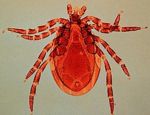Category:Arachnida
Jump to navigation
Jump to search
| This article has been peer reviewed but is awaiting expert review. If you would like to help with this, please see more information about expert reviewing. |
Classification
The phylum arthropoda is divided into several subphylums including Chelicerata (which includes the arachnids), Myriapoda, Hexapoda (which includes the insecta), Crustacea and Trilobitomorpha. These are then divided into many classes. The two of major veterinary importance are the insecta and arachnida classes.
The arachnids includes well known veterinary species such as ticks and mites. It also includes scorpions and spiders. Most of the structure and function of the arachnids is similar to the insecta.
Structure and Function
- Only two body divisions
- Cephalo-thorax
- Abdomen
- Three pairs of legs in the larval stages or four pairs of legs during the nymphal and adult stages
- No wings
- No antennae
- No compound eyes
- Small size
- E.g. Ticks are under 1cm in length
- E.g. Mites are under 1mm in length
Life cycles
- The larva (also called seed tick) develops from the egg
- The nymphal stage follows the larval stage
- The nymph then develops into an adult (i.e. sexually mature)
<ncl style=compact maxdepth=3 headings=bullet headstart=2
showcats=1 showarts=1>Category:Arachnida</ncl>
Subcategories
This category has the following 2 subcategories, out of 2 total.
Pages in category "Arachnida"
The following 3 pages are in this category, out of 3 total.

